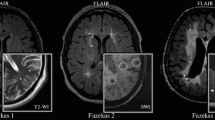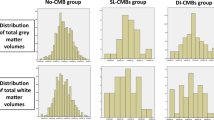Abstract
Objective
To evaluate the role of MR morphometry in the characterization of cerebral microangiopathy (CMA) in relation to clinical and neuropsychological impairment.
Subjects and Methods
3D MR images of 27 patients and 27 age–matched controls were morphometrically analysed for regional thickness. The normalized values were related to the patients’ clinical and neuropsychological scores. The patients were categorised according to the amount of structural MR signal changes. A ventricle index reflecting internal atrophy was related to MR morphology and cortical thickness as an indicator for external atrophy.
Results
Cortical thickness was significantly reduced in the patients group (3.03mm ± 0.26 vs. 3.22mm ± 0.13 in controls, p = 0.001). The severest loss of cortical thickness occurred in severe CMA. Internal and external atrophy evolved in parallel and both showed a significant relationship with structural MR–abnormalities (p < 0.05; r = –0.7; r = 0.67; r = –0.74, respectively). Neuropsychological performance correlated strongly with the loss of cortical thickness.
Conclusions
Cortical thickness was identified as the most sensitive parameter to characterize CMA. A strong correlation was found of morphometric parameters to the severity of CMA based on a score derived from T2–weighted MRI. The degree of cortical atrophy was directly related to the degree of neuropsychological impairment. Our findings suggest that the cortical thickness is a valid marker in the structural and clinical characterization of CMA.
Similar content being viewed by others
References
Ashburner J, Friston KJ (2000) Voxel- Based Morphometry – The Methods. Neuroimage 11:805–821
Barkhof F, Scheltens P (2002) Imaging of White Matter Lesions. Cerebrovasc Dis 13(Suppl 2):21–30
Chung MK, Worsley KJ, Robbins S, Paus T, Taylor J, Giedd JN, Rapoport JL, Evans AC (2003) Deformation–based surface morphometry applied to gray matter deformation. Neuroimage 18:198–213
De Deyn PP, Goeman J, Engelborghs S, Hauben U, D’Hooge R, Baro F, Pickut BA (1999) From Neuronal and Vascular Impairment to Dementia. Pharmacopsychiatry 32(Suppl):17–24
Delis DC, Kramer JH, Kaplan E, Obler BA (1987) The California verbal learning test: Adult version. San Antonio, Psychological Corporation
Desmond DW (2002) Cognition and White Matter Lesions. Cerebrovasc Dis 13(Suppl 2):53–57
Double KL, Halliday GM, Kril JJ, Harasty JA, Cullen K, Brooks WS, Creasey H, Broe GA (1996) Topography of Brain Atrophy During Normal Aging and Alzheimer’s Disease. Neurobiol Aging 17:513–521
Du AT, Schuff N, Laakso MP, Zhu XP, Jagust WJ, Yaffe K, Kramer JH, Miller BL, Reed BR, Norman D, Chui HC, Weiner MW (2002) Effects of subcortical ischemic vascular dementia and AD on entorhinal cortex and hippocampus. Neurology 58:1635–1641
Englund E (2002) Neuropathology of White Matter Lesions in Vascular Cognitive Impairment. Cerebrovasc Dis 13(Suppl 2):11–15
Erkinjuntti T, Hachinski VC (1993) Rethinking Vascular Dementia; Cerebrovasc Dis 3:3–23
Erkinjuntti T (2002) Subcortical Vascular Dementia. Cerebrovasc Dis 13(Suppl 2):58–60
Fazekas F, Kleinert R, Offenbacher H, Schmidt R, Kleinert G, Payer F, Radner H, Lechner H (1993) Pathologic correlates of incidental MRI white matter signal hyperintensities. Neurology 43:1683–1689
Fein G, Van Dyke C, Davenport L, Turetsky B, Brant-Zawadzki M, Zatz L, Dillon W, Valk P (1990) Preservation of Normal Cognitive Functioning in Elderly Subjects With Extensive White- Matter Lesions of Long Duration. Arch Gen Psychiatry 47:220–223
Filipek PA, Kennedy DN, Caviness VS Jr, Rossnick SL, Spraggins TA, Starewicz PM (1989) Magnetic Resonance Imaging-based Brain Morphometry: Development and Application to Normal Subjects. Ann Neurol 25:61–67
Free SL, O’Higgins P, Maudgil DD, Dryden IL, Lemieux L, Fish DR, Shorvon SD (2001) Landmark-Based Morphometrics of the Normal Adult Brain Using MRI. Neuroimage 13:801–813
Guttmann CR, Jolesz FA,Kikinis R, Killiany RJ,Moss MB, Sandor T, Albert MS (1998) White matter changes with normal aging. Neurology 50:972–978
Hantson L, De Weerdt W, De Keyser J, Diener HC, Franke C, Palm R, Van Orshoven M, Schoonderwalt H, De Klippel N,Herroelen L, et al. (1994) The European Stroke Scale. Stroke 25:2214–2219
Hund–Georgiadis M, Norris DG, Guthke T, Cramon DY (2001) Characterization of Cerebral Small Vessel Disease by Proton Spectroscopy and Morphological Magnetic Resonance. Cerebrovasc Dis 12:82–90
Jack CR, Peterson RC, Xu Y,O’Brien PC, Smith GE, Ivnik RJ, Boeve BF, Tangalos EG, Kokmen E (2000) Rates of hippocampal atrophy correlate with change in clinical status in aging and AD. Neurology 55:484–489
Kabani N, Le Goualher G, MacDonald D, Evans AC (2001) Measurement of Cortical Thickness Using an Automated 3-D Algorithm: A Validation Study. Neuroimage 13:375–380
Kalaria RN (2002) Small Vessel Disease and Alzheimer’s Dementia: Pathological Considerations. Cerebrovasc Dis 13(Suppl 2):48–52
Kril JJ, Patel S, Harding AJ, Halliday GM (2002) Patients with vascular dementia due to microvascular pathology have significant hippocampal neuronal loss. J Neurol Neurosurg Psychiatry 72:747–751
Laakso MP, Partanen K, Riekkinen P, Lehtovirta M, Helkala EL, Hallikainen M, Hanninen T, Vainio P, Soininen H (1996) Hippocampal volumes in Alzheimer’s disease, Parkinson’s disease with and without dementia, and in vascular dementia. An MRI study. Neurology 46:678–681
Lohmann G, Preul C, Hund–Georgiadis M (2003) Geometry–preserving white matter segmentation using T1– weighted MRI-data. In: Proc. Conf. Human Brain Mapping, New York, NY, June 18–22, (accepted)
Lohmann G, Preul C, Hund–Georgiadis M (2003) Morphology–based cortical thickness estimation. In: Proc. Conf. on Information Processing in Medical Imaging (IPMI 2003),Ambleside, UK, July 20–25 (accepted)
Lohmann G, von Cramon DY (2000) Automatic labelling of the human cortical surface using sulcal basins. Med Image Anal 6:8–28
MacDonald D, Kabani N, Avis D, Evans AC (2000) Automated 3–D Extraction of Inner and Outer Surfaces of Cerebral Cortex from MRI. Neuroimage 12:340–356
Mielke R, Herholz K, Grond M, Kessler J, Heiss WD (1992) Severity of Vascular Dementia Is Related to Volume of Metabolically Impaired Tissue. Arch Neurol 49:909–913
Miyao S, Takano A, Teramoto J, Takahashi A (1992) Leukoaraiosis in relation to prognosis for patients with lacunar infarctions. Stroke 23:1434–1438
Mungas D, Reed BR, Jagust WJ, DeCarli C, Mack WJ, Kramer JH, Weiner MW, Schuff N, Chui HC (2002) Volumetric MRI predicts rate of cognitive decline related to AD and cerebrovascular disease. Neurology 59:867–873
Norris DG (2000) Reduced power multislice MDEFT imaging. J Magn Reson Imaging 11(4):445–451
Pantoni L, Garcia JH (1997) Pathogenesis of Leukoaraiosis: A Review. Stroke 28:652–659
Pantoni L (2002) Pathophysiology of Age-Related Cerebral White Matter Changes. Cerebrovasc Dis 13(Suppl 2):7–10
Quester R, Schröder R (1997) The shrinkage of the human brain stem during formalin fixation and embedding in paraffin. J Neurosci Methods 75:81–89
Reed BR, Eberling JL, Mungas D, Weiner M, Jagust WJ (2001) Frontal Lobe Hypometabolism Predicts Cognitive Decline in Patients With Lacunar Infarcts. Arch Neurol 58:493–497
Regeur L (2000) Increasing loss of brain tissue with increasing dementia: a stereological study of post-mortem brains from elderly females. Eur J Neurol 7:47–54
Reiche W, Weiller C, Weigmann R, Kaiser HJ, Bull U, Schneider R, Ringelstein EB (1991) Comparison of MRT and SPECT findings in Patients with Cerebral Microangiopathy. Nuklearmedizin 30:161–169
Roman GC (1996) From UBOs to Binswanger’s disease. Impact of magnetic resonance imaging on vascular dementia research. Stroke 27:1269–1273
Sabri O, Hellwig D, Kaiser HJ, Doherty C, Schneider R, Mull M, Willmes von Hinckeldey KW, Bull U, Thron A, Ringelstein EB (1995) Effect of morphological changes on perfusion and metabolism in cerebral microangiopathy. A comparison of PET, SPECT, and magnetic resonance imaging findings. Nuklearmedizin 34:50–56 (Ger)
Sabri O, Hellwig D, Schreckenberger M, Cremerius U, Schneider R, Kaiser HJ, Doherty C, Mull M, Ringelstein EB, Buell U (1998) Correlation of Neuropsychological, Morphological and Functional (Regional Cerebral Blood Flow and Glucose Utilization) Findings in Cerebral Microangiopathy. J Nucl Med 39:147–154
Sabri O, Ringelstein EB, Hellwig D, Schneider R, Schreckenberger M, Kaiser HJ, Mull M, Buell U (1999) Neuropsychological Impairment Correlates With Hypoperfusion and Hypometabolism but Not With Severity of White Matter Lesions on MRI in Patients With Cerebral Microangiopathy. Stroke 30:556–566
Schmidt R, Schmidt H, Kapeller P, Lechner A, Fazekas F (2002) Evolution of White Matter Lesions. Cerebrovasc Dis 13(Suppl 2):16–20
Spinks R, Magnotta VA, Andreasen NC, Albright KC, Ziebell S, Nopoulos P, Cassell M (2002) Manual and Automated Measurement of the Whole Thalamus and Mediodorsal Nucleus Using Magnetic Resonance Imaging. Neuroimage 17:631–642
Talairach J, Tournoux P (1988) Co-Planar Stereotaxis Atlas of the Human Brain. New York: Thieme
van Swieten JC, Geyskes GG, Derix MM, Peeck BM, Ramos LM, van Latum JC, van Gijn J (1991) Hypertension in the Elderly Is Associated with White Matter Lesions and Cognitive Decline. Ann Neurol 30:825–830
Wilson B, Alderman N, Burgess PW, (1996) Behavioural assessment of the dysexecutive syndrome. Bury St. Edmunds, England, Thames Valley Test company
Wolfram H, Neumann J, Wieczorek V (1986) Psychologische Leistungstests in der Neurologie und Psychiatrie. Thieme, Leipzig, Germany
Zimmermann P, Fimm B (1993): Attentional testing. Handbuch, Psytest, Hogrefe, Göttingen (Ger)
Author information
Authors and Affiliations
Corresponding author
Rights and permissions
About this article
Cite this article
Preul, C., Lohmann, G., Hund–Georgiadis, M. et al. Morphometry demonstrates loss of cortical thickness in cerebral microangiopathy. J Neurol 252, 441–447 (2005). https://doi.org/10.1007/s00415-005-0671-9
Received:
Revised:
Accepted:
Published:
Issue Date:
DOI: https://doi.org/10.1007/s00415-005-0671-9




